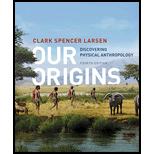
Concept explainers
Introduction: The genus Homo comprises modern humans as well as their close relatives. This genus is defined by certain behavioral as well as physical characteristics such as the small face, small jaws, and large brain.
Answer to Problem 1SQ
Correct answer: Option d) short legs relative to arms
Explanation of Solution
Reasons for the correct answer:
Option d) is given as “short legs relative to arms”.
Most of the anatomical characteristics differ between early australopithecine species and Homo habilis. The early australopithecines had a huge chewing complex and small brain. But the chewing complex of Homo habilis was smaller and the brain was large. The legs of Homo habilis were short relative to their arms and this feature was similar to the early australopithecine species.
Hence option d) is correct.
Reasons for the incorrect answers:
Option a) is given as “a small brain”. The early australopithecines had a smaller brain but the brain of Homo habilis was larger. Hence, option a) is incorrect.
Option b) is given as “a large chewing complex”. The early australopithecines had a huge chewing complex but the chewing complex of Homo habilis was smaller. Hence, option b) is incorrect.
Option c) is given as “a large face and large jaws”. The anatomical characteristics such as large jaws and large faces were found in early australopithecines whereas Homo habilis has face and jaws smaller than early australopithecines. Hence, option c) is incorrect.
Therefore, options a), b), and c) are incorrect.
Therefore, the anatomical characteristic that was similar between the earliest australopithecine species and the Homo habilis was legs that are shorter when compared to arms.
Want to see more full solutions like this?
Chapter 11 Solutions
Our Origins: Discovering Physical Anthropology (Fourth Edition)
- please fill in missing parts , thank youarrow_forwardplease draw in the answers, thank youarrow_forwarda. On this first grid, assume that the DNA and RNA templates are read left to right. DNA DNA mRNA codon tRNA anticodon polypeptide _strand strand C с A T G A U G C A TRP b. Now do this AGAIN assuming that the DNA and RNA templates are read right to left. DNA DNA strand strand C mRNA codon tRNA anticodon polypeptide 0 A T G A U G с A TRParrow_forward
- Please identify the curve shown below. What does this curve represent? Please identify A, B, C, D, and E (the orange oval). What is occurring in these regions?arrow_forwardPlease identify the test shown here. 1) What is the test? 2) What does the test indicate? How is it performed? What is CX? 3) Why might the test be performed in a clinical setting? GEN CZ CX CPZ PTZ CACarrow_forwardDetermine how much ATP would a cell produce when using fermentation of a 50 mM glucose solution?arrow_forward
- Determine how much ATP would a cell produce when using aerobic respiration of a 7 mM glucose solution?arrow_forwardDetermine how much ATP would a cell produce when using aerobic respiration to degrade one small protein molecule into 12 molecules of malic acid, how many ATP would that cell make? Malic acid is an intermediate in the Krebs cycle. Assume there is no other carbon source and no acetyl-CoA.arrow_forwardIdentify each of the major endocrine glandsarrow_forward

 Human Biology (MindTap Course List)BiologyISBN:9781305112100Author:Cecie Starr, Beverly McMillanPublisher:Cengage Learning
Human Biology (MindTap Course List)BiologyISBN:9781305112100Author:Cecie Starr, Beverly McMillanPublisher:Cengage Learning Concepts of BiologyBiologyISBN:9781938168116Author:Samantha Fowler, Rebecca Roush, James WisePublisher:OpenStax College
Concepts of BiologyBiologyISBN:9781938168116Author:Samantha Fowler, Rebecca Roush, James WisePublisher:OpenStax College Biology (MindTap Course List)BiologyISBN:9781337392938Author:Eldra Solomon, Charles Martin, Diana W. Martin, Linda R. BergPublisher:Cengage Learning
Biology (MindTap Course List)BiologyISBN:9781337392938Author:Eldra Solomon, Charles Martin, Diana W. Martin, Linda R. BergPublisher:Cengage Learning Biology: The Unity and Diversity of Life (MindTap...BiologyISBN:9781305073951Author:Cecie Starr, Ralph Taggart, Christine Evers, Lisa StarrPublisher:Cengage Learning
Biology: The Unity and Diversity of Life (MindTap...BiologyISBN:9781305073951Author:Cecie Starr, Ralph Taggart, Christine Evers, Lisa StarrPublisher:Cengage Learning Biology Today and Tomorrow without Physiology (Mi...BiologyISBN:9781305117396Author:Cecie Starr, Christine Evers, Lisa StarrPublisher:Cengage Learning
Biology Today and Tomorrow without Physiology (Mi...BiologyISBN:9781305117396Author:Cecie Starr, Christine Evers, Lisa StarrPublisher:Cengage Learning





